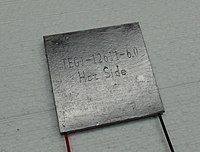
Photo from wikipedia
The continuously growing number of short-life electronics equipment inherently results in a massive amount of problematic waste, which poses risks of environmental pollution, endangers human health, and causes socioeconomic problems.… Click to show full abstract
The continuously growing number of short-life electronics equipment inherently results in a massive amount of problematic waste, which poses risks of environmental pollution, endangers human health, and causes socioeconomic problems. Hence, to mitigate these negative impacts, it is our common interest to substitute conventional materials (polymers and metals) used in electronics devices with their environmentally benign renewable counterparts, wherever possible, while considering the aspects of functionality, manufacturability, and cost. To support such an effort, in this study, we explore the use of biodegradable bioplastics, such as polylactic acid (PLA), its blends with polyhydroxybutyrate (PHB) and composites with pyrolyzed lignin (PL), and multiwalled carbon nanotubes (MWCNTs), in conjunction with processes typical in the fabrication of electronics components, including plasma treatment, dip coating, inkjet and screen printing, as well as hot mixing, extrusion, and molding. We show that after a short argon plasma treatment of the surface of hot-blown PLA-PHB blend films, percolating networks of single-walled carbon nanotubes (SWCNTs) having sheet resistance well below 1 kΩ/□ can be deposited by dip coating to make electrode plates of capacitive touch sensors. We also demonstrate that the bioplastic films, as flexible dielectric substrates, are suitable for depositing conductive micropatterns of SWCNTs and Ag (1 kΩ/□ and 1 Ω/□, respectively) by means of inkjet and screen printing, with potential in printed circuit board applications. In addition, we exemplify compounded and molded composites of PLA with PL and MWCNTs as excellent candidates for electromagnetic interference shielding materials in the K-band radio frequencies (18.0–26.5 GHz) with shielding effectiveness of up to 40 and 46 dB, respectively.
Journal Title: ACS Applied Materials & Interfaces
Year Published: 2021
Link to full text (if available)
Share on Social Media: Sign Up to like & get
recommendations!